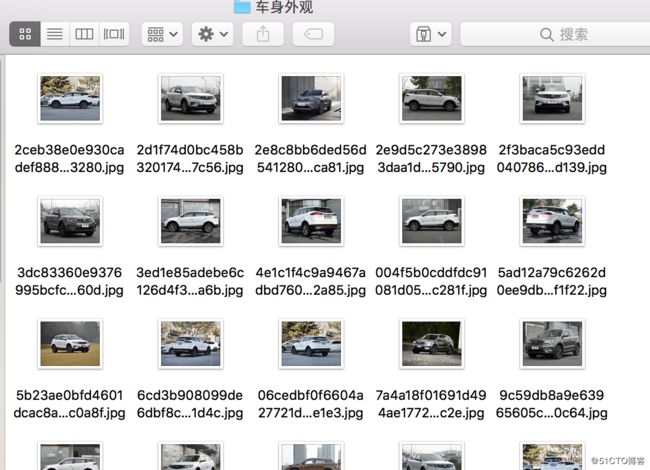原文链接:https://www.fkomm.cn/article/2018/8/7/32.html
目的
Scrapy框架为文件和图片的下载专门提供了两个Item Pipeline 它们分别是:
-
FilePipeline
- ImagesPipeline
这里主要介绍ImagesPipeline!!
目标分析:
这次我们要爬的是汽车之家:car.autohome.com.cn。最近喜欢吉利博越,所以看了不少这款车的资料。
我们就点开博越汽车的图片网站:
https://car.autohome.com.cn/pic/series/3788.html
传统的Scrapy框架图片下载
Scrapy 框架的实施:
1.创建scrapy项目和爬虫:
$ scrapy startproject Geely
$ cd Geely
$ scrapy genspider BoYue car.autohome.com.cn2.编写items.py:
import scrapy
class GeelyItem(scrapy.Item):
# define the fields for your item here like:
# name = scrapy.Field()
# 存储图片分类
catagory = scrapy.Field()
# 存储图片地址
image_urls = scrapy.Field()
# ImagesPipeline
images = scrapy.Field()3.编写Spider:
# -*- coding: utf-8 -*-
import scrapy
#导入CrawlSpider模块 需改写原来的def parse(self,response)方法
from scrapy.spiders import CrawlSpider ,Rule
#导入链接提取模块
from scrapy.linkextractors import LinkExtractor
from Geely.items import GeelyItem
class BoyueSpider(CrawlSpider):
name = 'BoYue'
allowed_domains = ['car.autohome.com.cn']
start_urls = ['https://car.autohome.com.cn/pic/series/3788.html']
#如需要进行页面解释则使用callback回调函数 因为有下一页,所以我们需要跟进,这里使用follow令其为True
rules = {
Rule(LinkExtractor(allow=r'https://car.autohome.com.cn/pic/series/3788.+'), callback= 'parse_page', follow=True),
}
def parse_page(self, response):
catagory = response.xpath('//div[@class = "uibox"]/div/text()').get()
srcs = response.xpath('//div[contains(@class,"uibox-con")]/ul/li//img/@src').getall()
#map(函数,参数二),将参数二中的每个都进行函数计算并返回一个列表
srcs = list(map(lambda x:x.replace('t_',''),srcs))
srcs = list(map(lambda x:response.urljoin(x),srcs))
yield GeelyItem(catagory=catagory, image_urls = srcs)4.编写PIPELINE:
import os
from urllib import request
class GeelyPipeline(object):
def __init__(self):
#os.path.dirname()获取当前文件的路径,os.path.join()获取当前目录并拼接成新目录
self.path = os.path.join(os.path.dirname(__file__), 'images')
# 判断路径是否存在
if not os.path.exists(self.path):
os.mkdir(self.path)
def process_item(self, item, spider):
#分类存储
catagory = item['catagory']
urls = item['image_urls']
catagory_path = os.path.join(self.path, catagory)
#如果没有该路径即创建一个
if not os.path.exists(catagory_path):
os.mkdir(catagory_path)
for url in urls:
#以_进行切割并取最后一个单元
image_name = url.split('_')[-1]
request.urlretrieve(url,os.path.join(catagory_path,image_name))
return item5.编写settings.py
BOT_NAME = 'Geely'
SPIDER_MODULES = ['Geely.spiders']
NEWSPIDER_MODULE = 'Geely.spiders'
# Obey robots.txt rules
ROBOTSTXT_OBEY = False
ITEM_PIPELINES = {
'Geely.pipelines.GeelyPipeline': 1,
}6.让项目跑起来:
$ scrapy crawl BoYue
使用Images_pipeline进行图片下载
使用步骤:
-
定义好一个item,然后定义两个属性 image_urls 和 images。 image_urls是用来存储需要下载的文件的url链接,列表类型;
-
当文件下载完成后,会把文件下载的相关信息存储到item的images属性中。例如:下载路径,下载url 和文件的效验码;
-
再配置文件settings.py中配置FILES_STORE,指定文件下载路径;
- 启动pipeline,在ITEM_PIPELINES中设置自定义的中间件!!!
具体步骤
在上面的基础上修改
1.修改settings.py
ITEM_PIPELINES = {
# 'Geely.pipelines.GeelyPipeline': 1,
# 'scrapy.pipelines.images.ImagesPipeline': 1,
'Geely.pipelines.GeelyImagesPipeline': 1,
}
#工程根目录
project_dir = os.path.dirname(__file__)
#下载图片存储位置
IMAGES_STORE = os.path.join(project_dir, 'images')2.改写pipelines,py
# -*- coding: utf-8 -*-
# Define your item pipelines here
#
# Don't forget to add your pipeline to the ITEM_PIPELINES setting
# See: https://doc.scrapy.org/en/latest/topics/item-pipeline.html
import os
from urllib import request
from scrapy.pipelines.images import ImagesPipeline
from Geely import settings
# class GeelyPipeline(object):
# def __init__(self):
# #os.path.dirname()获取当前文件的路径,os.path.join()获取当前目录并拼接成新目录
# self.path = os.path.join(os.path.dirname(__file__), 'images')
# # 判断路径是否存在
# if not os.path.exists(self.path):
# os.mkdir(self.path)
# def process_item(self, item, spider):
# #分类存储
# catagory = item['catagory']
# urls = item['image_urls']
# catagory_path = os.path.join(self.path, catagory)
# #如果没有该路径即创建一个
# if not os.path.exists(catagory_path):
# os.mkdir(catagory_path)
# for url in urls:
# #以_进行切割并取最后一个单元
# image_name = url.split('_')[-1]
# request.urlretrieve(url,os.path.join(catagory_path,image_name))
# return item
# 继承ImagesPipeline
class GeelyImagesPipeline(ImagesPipeline):
# 该方法在发送下载请求前调用,本身就是发送下载请求的
def get_media_requests(self, item, info):
# super()直接调用父类对象
request_objects = super(GeelyImagesPipeline, self).get_media_requests(item, info)
for request_object in request_objects:
request_object.item = item
return request_objects
def file_path(self, request, response=None, info=None):
path = super(GeelyImagesPipeline, self).file_path(request, response, info)
# 该方法是在图片将要被存储时调用,用于获取图片存储的路径
catagory = request.item.get('catagory')
# 拿到IMAGES_STORE
images_stores = settings.IMAGES_STORE
catagory_path = os.path.join(images_stores, catagory)
#判断文件名是否存在,如果不存在创建文件
if not os.path.exists(catagory_path):
os.mkdir(catagory_path)
image_name = path.replace('full/','')
image_path = os.path.join(catagory+'/',image_name)
return image_path3.让项目跑起来:
$ scrapy crawl BoYue
将会得到与原来相同的结果!!!!


